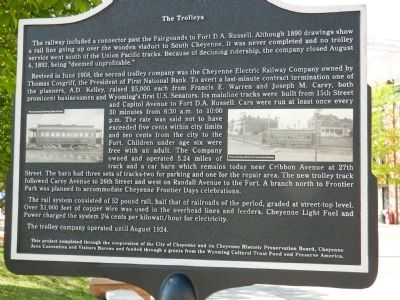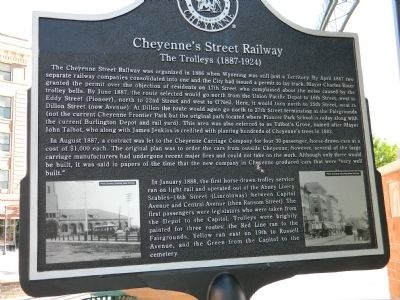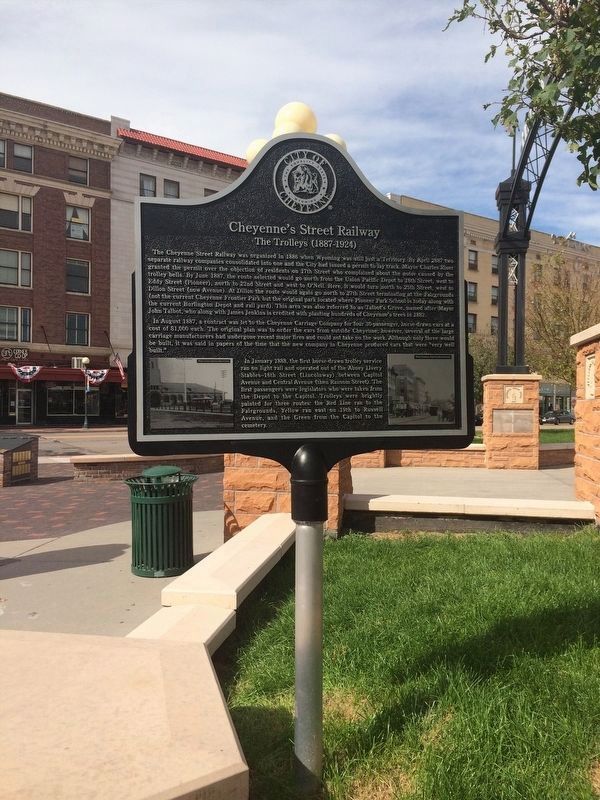The Trolleys / Cheyenne's Street Railway
The Trolleys
The railway included a connector past the Fairgrounds to Fort S.A. Russell. Although 1890 drawings show a fail line going up over the wooden viaduct to South Cheyenne, it was never completed and no trolley service went south of the Union Pacific tracts. Because of declining ridership, the company closed August 4, 1892, being "deemed unprofitable."
Revived in June 1908, the second trolley company was the Cheyenne Electric Railway Company owned by Thomas Cosgriff, the President of First National Bank. To avert a last minute contract termination one of the planners, A.D. Kelley, raised $5,000 each from Francis E. Warren and Joseph m. Carey, both prominent businessmen and Wyoming's first U.S. Senators. Its mainline tracts were built from 15th Street and Capitol Avenue to Fort D.A. Russell. Cars were run at least once every 30 minutes from 6:30 a.m. to 10:00 p.m. The rate was said not to have exceeded five cents within city limits and ten cents from the city to the Fort. Children under age six were free with an adult. The Company owned and operated 5.24 miles of track and a car barn which remains today near Cribbon Avenue at 27th Street. The barn had three sets of tracks - two for parking and one for the repair area. The new trolley track followed Carey Avenue to 26th Street and west on Randall Avenue to the Fort.
A branch north to Frontier Park was planned to accommodate Cheyenne Frontier Days celebrations.The rail system consisted of 52 pound rail, half that of railroads of the period, graded at street-top level. Over 51,000 feet of copper wire was used in the overhead lines and feeders. Cheyenne Light Fuel and Power charged the system 2 1/4 cents per kilowatt/hour for electricity>p>The trolley company operated until August 1924.
Cheyenne's Street Railway
The Trolleys (1887 - 1924)
The Cheyenne Street Railway was organized in 1886 when Wyoming was still just a Territory. By April 1887 tow separate railway companies consolidated into one and the City had issued a permit to lay track. Mayor Charles Riner granted the permit over the objection of residents on 17th Street who complained about the noise caused by the trolley bells. By June 1887, the rout selected would go north from the Union Pacific Depot to 16th Street, west to Eddy Street (Pioneer), north to 22nd Street and west to O;Neil. Here, it would turn north to 25th Street, west to Dillon Street (now Avenue). At Dillon the route would again go north to 27th Street terminating at the Fairgrounds (now the current Cheyenne Frontier Park but the original park located where Pioneer Park School is today along with the current Burlington depot and rail yard). This area was also referred to as Talbot's Grove, named after
In August 1887, a contract was let to the Cheyenne Carriage Company for four 30-passenger, horse-drawn cars at a cost of $1,000 each. The original plan was to order the cars from outside Cheyenne; however, several of the large carriage manufacturers had under gone recent major fires and could not take on the work. Although only three would be built, it was said in papers of the time that the new company in Cheyenne produced cars that were "very well built."
In January 1888, the first horse-drawn trolley service ran on light rail and operated out of the Abney Livery Stables - 16th Street (Lincolnway) between Capitol Avenue and Central Avenue (then Ransom Street). The first passengers were legislators who were taken from the Depot to the Capitol. Trolleys were brightly painted for three routes; the Red Line ran to the Fairgrounds, Yellow ran east on 19th to Russell Avenue, and the Green from the Capitol to the cemetery.
Topics. This historical marker is listed in this topic list: Railroads & Streetcars. A significant historical month for this entry is January 1888.
Location. 41° 7.958′ N, 104° 48.905′ W. Marker is in Cheyenne, Wyoming, in Laramie County. Marker is at the intersection of Lincolnway and Capitol Avenue on Lincolnway. Touch for map
Other nearby markers. At least 8 other markers are within walking distance of this marker. 1974 Downtown National Historic District (here, next to this marker); The Union Pacific Railroad (within shouting distance of this marker); The first steam-powered locomotive reached Cheyenne on November 14, 1867 (within shouting distance of this marker); Tom Horn (about 300 feet away, measured in a direct line); Historic Plains Hotel (about 300 feet away); Union Pacific Railroad Depot (about 400 feet away); The Burlington Routes (about 400 feet away); Suffrage Tablet (about 400 feet away). Touch for a list and map of all markers in Cheyenne.
Credits. This page was last revised on January 12, 2024. It was originally submitted on September 14, 2011, by Bill Pfingsten of Bel Air, Maryland. This page has been viewed 988 times since then and 76 times this year. Photos: 1, 2. submitted on September 14, 2011, by Bill Pfingsten of Bel Air, Maryland. 3. submitted on January 12, 2024, by Adam Margolis of Mission Viejo, California.


